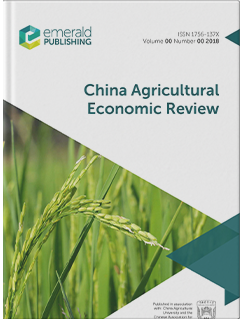食品价格动态与区域集群:中国鸡蛋价格的机器学习分析
IF 4.6
2区 经济学
Q1 AGRICULTURAL ECONOMICS & POLICY
引用次数: 3
摘要
本研究使用机器学习技术对2000年以后中国的区域零售鸡蛋价格进行聚类。此外,它将机器学习结果与计量经济模型相结合,研究集群隶属关系的决定因素。鸡蛋是一种价格低廉、营养丰富且可持续的动物食品。中国是世界上鸡蛋产量和消费量最大的国家。区域集聚可以帮助政府提高价格政策的准确性,帮助生产者做出更好的投资决策。结果完全是由数据驱动的。设计/方法/方法本研究引入了考虑时间序列特性的动态时间翘曲(DTW)算法来分析中国省级鸡蛋价格。结果与其他几种算法(如TADPole)进行了比较。DTW更优越,尽管它在计算上很昂贵。聚类后,运行多项式逻辑模型来研究聚类隶属关系的决定因素。研究结果该研究确定了三种类型。第一集群包括12个省,第二集群包括2个省,是中国产蛋大省及其周边省份。第三个集群主要是鸡蛋进口地区。集群1和集群2的价格波动较大。作者证实,由于交易成本的影响,进口地区的价格波动可能较小。实际意义:机器学习技术可以帮助政府制定更精确的政策,帮助生产商做出更好的投资决策。原创性/价值这是第一篇使用机器学习技术聚类食品价格的论文。它还结合了机器学习和计量经济学模型,以更好地研究价格动态。本文章由计算机程序翻译,如有差异,请以英文原文为准。
Food price dynamics and regional clusters: machine learning analysis of egg prices in China
PurposeThe study uses machine learning techniques to cluster regional retail egg prices after 2000 in China. Furthermore, it combines machine learning results with econometric models to study determinants of cluster affiliation. Eggs are an inexpensiv, nutritious and sustainable animal food. Contextually, China is the largest country in the world in terms of both egg production and consumption. Regional clustering can help governments to imporve the precision of price policies and help producers make better investment decisions. The results are purely driven by data.Design/methodology/approachThe study introduces dynamic time warping (DTW) algorithm which takes into account time series properties to analyze provincial egg prices in China. The results are compared with several other algorithms, such as TADPole. DTW is superior, though it is computationally expensive. After the clustering, a multinomial logit model is run to study the determinants of cluster affiliation.FindingsThe study identified three clusters. The first cluster including 12 provinces and the second cluster including 2 provinces are the main egg production provinces and their neighboring provinces in China. The third cluster is mainly egg importing regions. Clusters 1 and 2 have higher price volatility. The authors confirm that due to transaction costs, the importing areas may have less price volatility.Practical implicationsThe machine learning techniques could help governments make more precise policies and help producers make better investment decisions.Originality/valueThis is the first paper to use machine learning techniques to cluster food prices. It also combines machine learning and econometric models to better study price dynamics.
求助全文
通过发布文献求助,成功后即可免费获取论文全文。
去求助
来源期刊

China Agricultural Economic Review
AGRICULTURAL ECONOMICS & POLICY-
CiteScore
9.80
自引率
5.90%
发文量
41
审稿时长
>12 weeks
期刊介绍:
Published in association with China Agricultural University and the Chinese Association for Agricultural Economics, China Agricultural Economic Review publishes academic writings by international scholars, and particularly encourages empirical work that can be replicated and extended by others; and research articles that employ econometric and statistical hypothesis testing, optimization and simulation models. The journal aims to publish research which can be applied to China’s agricultural and rural policy-making process, the development of the agricultural economics discipline and to developing countries hoping to learn from China’s agricultural and rural development.
 求助内容:
求助内容: 应助结果提醒方式:
应助结果提醒方式:


